The AnandTech Coffee Lake Review: Initial Numbers on the Core i7-8700K and Core i5-8400
by Ian Cutress on October 5, 2017 9:00 AM EST- Posted in
- CPUs
- Intel
- Core i5
- Core i7
- Core i3
- 14nm
- Coffee Lake
- 14++
- Hex-Core
- Hyperthreading
Benchmarking Performance: CPU System Tests
Our first set of tests is our general system tests. These set of tests are meant to emulate more about what people usually do on a system, like opening large files or processing small stacks of data. This is a bit different to our office testing, which uses more industry standard benchmarks, and a few of the benchmarks here are relatively new and different.
All of our benchmark results can also be found in our benchmark engine, Bench.
Strategic AI
One of the hot button topics this year (and for the next few years, no doubt) is how technology is shifting to using artificial intelligence and purpose built AI hardware to perform better analysis in low power environments. AI is not relatively new as a concept, as we have had it for over 50 years. What is new is the movement to neural network based training and inference: moving from ‘if this then that’ sort of AI to convolutional networks that can perform fractional analysis of all the parameters.
Unfortunately the movement of the neural-network ecosystem is fast paced right now, especially in software. Every few months or so, announcements are made on new software frameworks, improvements in accuracy, or fundamental paradigm shifts in how these networks should be calculated for accuracy, power, performance, and what the underlying hardware should support in order to do so. There is no situational AI benchmarking tools using network topologies that will remain relevant in 2-4 months, let alone an 18-24 month processor benchmark cycle. So to that end our AI test becomes the best of the rest: strategic AI in the latest video games.
For our test we use the in-game Civilization 6 AI benchmark with a few custom modifications. Civilization is one of the most popular strategy video games on the market, heralded for its ability for extended gameplay and for users to suddenly lose 8 hours in a day because they want to play ‘one more turn’. A strenuous setting would involve a large map with 20 AI players on the most difficult settings, leading to a turn time (waiting for the AI players to all move in one turn) to exceed several minutes on a mid-range system. Note that a Civilization game can easily run for over 500 turns and be played over several months due to the level of engagement and complexity.
Before the benchmark is run, we change the game settings for medium visual complexity at a 1920x1080 resolution while using a GTX 1080 graphics card, such that any rendered graphics are not interfering with the benchmark measurements. Our benchmark run uses a command line method to call the built-in AI benchmark, which features 8 AI players on a medium size map but in a late game scenario with most of the map discovered, each civilization in the throes of modern warfare. We set the benchmark to play for 15 turns, and output the per-turn time, which is then read into the script with the geometric mean calculated. This benchmark is newer than most of the others, so we only have a few data points so far:

Our Strategic AI test is new to the scene, and it looks like there is at least an asymptotic result wken you have a 'good enough' processor.
PDF Opening
First up is a self-penned test using a monstrous PDF we once received in advance of attending an event. While the PDF was only a single page, it had so many high-quality layers embedded it was taking north of 15 seconds to open and to gain control on the mid-range notebook I was using at the time. This put it as a great candidate for our 'let's open an obnoxious PDF' test. Here we use Adobe Reader DC, and disable all the update functionality within. The benchmark sets the screen to 1080p, opens the PDF to in fit-to-screen mode, and measures the time from sending the command to open the PDF until it is fully displayed and the user can take control of the software again. The test is repeated ten times, and the average time taken. Results are in milliseconds.
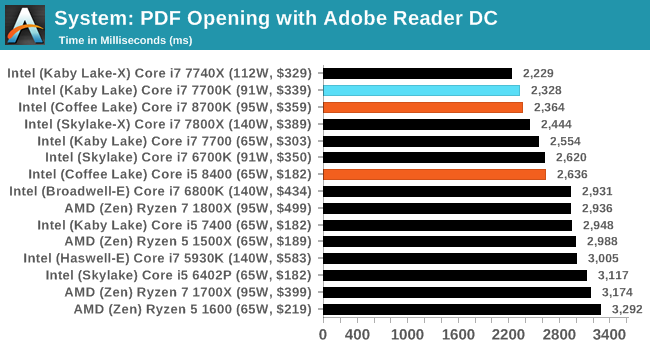
Single thread frequency usualy works well for PDF Opening, although as we add on more high performance cores it becomes more difficult for the system to pin that individual thread to a single core and get the full turbo boost - if anything flares up on any other core then it brings the frequencies down. I suspect that is what is happening here and the next couple of thests where the i7-8700K sits behind the i7-7700K and i7-7740X.
FCAT Processing: link
One of the more interesting workloads that has crossed our desks in recent quarters is FCAT - the tool we use to measure stuttering in gaming due to dropped or runt frames. The FCAT process requires enabling a color-based overlay onto a game, recording the gameplay, and then parsing the video file through the analysis software. The software is mostly single-threaded, however because the video is basically in a raw format, the file size is large and requires moving a lot of data around. For our test, we take a 90-second clip of the Rise of the Tomb Raider benchmark running on a GTX 980 Ti at 1440p, which comes in around 21 GB, and measure the time it takes to process through the visual analysis tool.
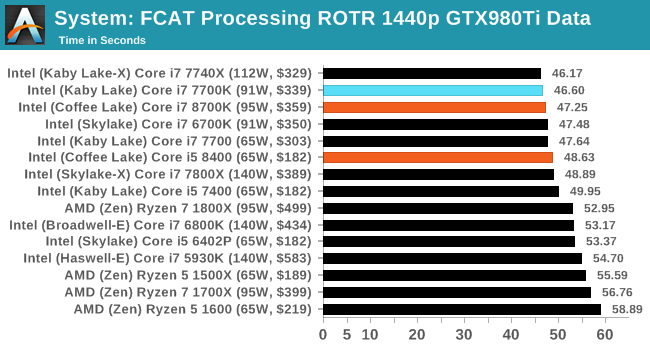
Dolphin Benchmark: link
Many emulators are often bound by single thread CPU performance, and general reports tended to suggest that Haswell provided a significant boost to emulator performance. This benchmark runs a Wii program that ray traces a complex 3D scene inside the Dolphin Wii emulator. Performance on this benchmark is a good proxy of the speed of Dolphin CPU emulation, which is an intensive single core task using most aspects of a CPU. Results are given in minutes, where the Wii itself scores 17.53 minutes.

3D Movement Algorithm Test v2.1: link
This is the latest version of the self-penned 3DPM benchmark. The goal of 3DPM is to simulate semi-optimized scientific algorithms taken directly from my doctorate thesis. Version 2.1 improves over 2.0 by passing the main particle structs by reference rather than by value, and decreasing the amount of double->float->double recasts the compiler was adding in. It affords a ~25% speed-up over v2.0, which means new data.
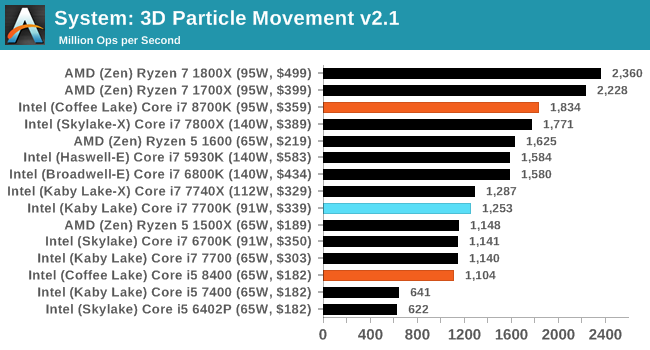
DigiCortex v1.20: link
Despite being a couple of years old, the DigiCortex software is a pet project for the visualization of neuron and synapse activity in the brain. The software comes with a variety of benchmark modes, and we take the small benchmark which runs a 32k neuron/1.8B synapse simulation. The results on the output are given as a fraction of whether the system can simulate in real-time, so anything above a value of one is suitable for real-time work. The benchmark offers a 'no firing synapse' mode, which in essence detects DRAM and bus speed, however we take the firing mode which adds CPU work with every firing.
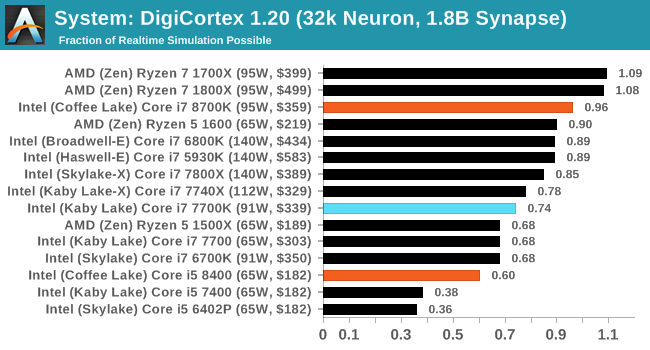
DigiCortex can take advantage of the extra cores, paired with the faster DDR4-2666 memory. The Ryzen 7 chips still sit at the top here however.
Agisoft Photoscan 1.3.3: link
Photoscan stays in our benchmark suite from the previous version, however now we are running on Windows 10 so features such as Speed Shift on the latest processors come into play. The concept of Photoscan is translating many 2D images into a 3D model - so the more detailed the images, and the more you have, the better the model. The algorithm has four stages, some single threaded and some multi-threaded, along with some cache/memory dependency in there as well. For some of the more variable threaded workload, features such as Speed Shift and XFR will be able to take advantage of CPU stalls or downtime, giving sizeable speedups on newer microarchitectures. The 1.3.3 test is relatively new, so has only been run on a few parts so far.
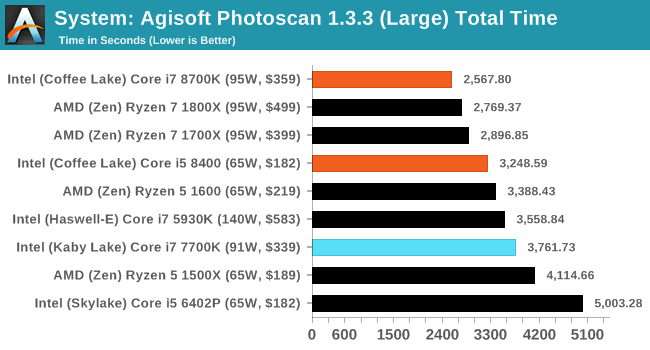










222 Comments
View All Comments
mkaibear - Saturday, October 7, 2017 - link
Well, I'd broadly agree with that!There are latency issues with that kind of approach but I'm sure they'd be solvable. It'll be interesting to see what happens with Intel's Mesh when it inevitably trickles down to the lower end / AMD's Infinity Fabric when they launch their APUs.
mapesdhs - Tuesday, October 10, 2017 - link
Such an idea is kinda similar to SGI's shared memory designs. Problem is, scalable systems are expensive, and these days the issue of compatibility is so strong, making anything new and unique is very difficult, companies just don't want to try out anything different. SGI got burned with this re their VW line of PCs.boeush - Saturday, October 7, 2017 - link
I think it's a **VERY** safe bet that most systems selling with an i7 8700/k will also include some sort of a discrete GPU. It's almost unimaginable that anyone would buy/build a system with such a CPU but no better GPU than integrated graphicsWhich makes the iGPU a total waste of space and a piece of useless silicon that consumers are needlessly paying for (because every extra square inch of die area costs $$$).
For high-end CPUs like the i7s, it would make much more sense to ditch the iGPU and instead spend that extra silicon to add an extra couple of cores, and a ton more cache. Then it would be a far better CPU for the same price.
So I'm totally with the OP on this one.
mkaibear - Sunday, October 8, 2017 - link
You need a better imagination!Of the many hundreds of computers I've bought or been responsible for speccing for corporate and educational entities, about half have been "performance" oriented (I'd always spec a decent i5 or i7 if there's a chance that someone might be doing something CPU limited - hardware is cheap but people are expensive...) Of those maybe 10% had a discrete GPU (the ones for games developers and the occasional higher-up's PC). All the rest didn't.
From chatting to my fellow managers at other institutions this is basically true across the board. They're avidly waiting for the Ryzen APUs to be announced because it will allow them to actually have competition in the areas they need it!
boeush - Sunday, October 8, 2017 - link
It's not surprising to see business customers largely not caring about graphics performance - or about the hit to CPU performance that results from splitting the TDP budget with the iGPU...In my experience, business IT people tend to be either penny-wise and pound-foolish, or obsessed with minimizing their departmental TCO while utterly ignoring company performance as a whole. If you could get a much better-performing CPU for the same money, and spend an extra $40 for a discrete GPU that matches or exceeds the iGPU's capabilities - would you care? Probably not. Then again, that's why you'd stick with an i5 - or a lower-grade i7. Save a hundred bucks on hardware per person per year; lose a few thousand over the same period in wasted time and decreased productivity... I've seen this sort of penny-pinching miscalculation too many times to count. (But yeah, it's much easier to quantify the tangible costs of hardware, than to assess/project the intangibles of sub-par performance...)
But when it comes specifically to the high-end i7 range - these are CPUs targeted specifically at consumers, not businesses. Penny-pinching IT will go for i5s or lower-grade i7s; large-company IT will go for Xeons and skip the Core line altogether.
Consumer builds with high-end i7s will always go with a discrete GPU (and often more than one at a time.)
mkaibear - Monday, October 9, 2017 - link
That's just not true dude. There are a bunch of use cases which spec high end CPUs but don't need anything more than integrated graphics. In my last but-one place, for example, they were using a ridiculous Excel spreadsheet to handle the manufacturing and shipping orders which would bring anything less than an i7 with 16Gb of RAM to its knees. Didn't need anything better than integrated graphics but the CPU requirements were ridiculous.Similarly in a previous job the developers had ludicrous i7 machines with chunks of RAM but only using integrated graphics.
Yes, some it managers are penny wise and pound foolish, but the decent ones who know what they're doing they spend the money on the right CPU for the job - and as I say a serious number of use cases don't need a discrete GPU.
...besides it's irrelevant because the integrated GPU has zero impact on performance for modern Intel chips, as I said the limit is thermal not package size.
If Intel whack an extra 2 cores on and clock them at the same rate their power budget is going up by 33% minimum - so in exchange for dropping the integrated GPU you get a chip which can no longer be cooled by a standard air cooler and has to have something special on there, adding cost and complexity.
Sticking with integrated GPUs is a no-brainer for Intel. It preserves their market share in that environment and has zero impact for the consumer, even gaming consumers.
boeush - Monday, October 9, 2017 - link
Adding 2 cores to a 6-core CPU drives the power budget up by 33% if and **ONLY IF** all cores are actually getting fully utilized. If that is the case, then the extra performance from those extra 2 cores would be indeed actually needed! (at least on those occasions, and would be, therefore, sorely missed in a 6-core chip.). Otherwise, any extra cores would be mostly idle, not significantly impacting power utilization, cooling requirements, or maximum single-thread performance.Equally important to the number of cores is the amount of cache. Cache takes up a lot of space, doesn't generate all that much heat (compared to the actual CPU pipeline components), but can boost performance hugely, especially on some tasks that are memory-constrained. Having more L1/L2/L3 cache would provide a much better bang for the buck when you need the CPU grunt (and therefore a high-end i7), than the waste of an iGPU (eating up ~50% of die area) ever could.
Again, when you're already spending top dollar on an i7 8700/k (presumable because you actually need high CPU performance), it makes little sense that you go, "well, I'd rather have **LOWER** CPU performance, than be forced to spend an extra $40 on a discrete GPU (that I could then reuse on subsequent system builds/upgrades for many years to come)"...
mkaibear - Tuesday, October 10, 2017 - link
Again, that's not true. Adding 2 cores to a 6 core CPU means that unless you find some way to prevent your OS from scheduling threads on it then all those cores are going to end up used somewhat - which means that you have to plan for your worst case TDP not your best case TDP - which means you have to engineer a cooling solution which will work for the full 8 core CPU, increasing costs to the integrator and the end user. Why do you think Intel's worked so hard to keep the 6-core CPU within a few watts of the old 4-core CPU?In contrast an iGPU can be switched on or off and remain that way, the OS isn't going to assign cores to it and result in it suddenly dissipating more power.
And again you're focussing on the extremely limited gamer side of things - in the real world you don't "reuse the graphics card for many years to come", you buy a machine which does what you need it to and what you project you'll need it to, then replace it at the end of whatever period you're amortising the purchase over. Adding a $40 GPU and paying the additional electricity costs to run that GPU over time means your TCO is significantly increased for zero benefits, except in a very small number of edge cases in which case you're probably better off just getting a HEDT system anyway.
The argument about cache might be a better one to go down, but the amount of cache in desktop systems doesn't have as big an impact on normal workflow tasks as you might expect - otherwise we'd see greater segmentation in the marketplace anyway.
In short, Intel introducing desktop processors without iGPUs makes no sense for them at all. It would benefit a small number of enthusiasts at a cost of winding up a large number of system integrators and OEMs, to say nothing of a huge stack of IT Managers across the industry who would suddenly have to start fitting and supporting discrete GPUs across their normal desktop systems. Just not a good idea, economically, statistically or in terms of customer service.
boeush - Tuesday, October 10, 2017 - link
The TDP argument as you are trying to formulate it is just silly. Either the iGPU is going to be in fact used on a particular build, or it's going to be disabled in favor of headless operation or a discrete GPU. If the iGPU is disabled, then it is the very definition of all-around WASTE - a waste of performance potential for the money, conversely/accordingly a waste of money, and a waste in terms of manufacturing/materials efficiency. On the other hand, if the iGPU is enabled, it is actually more power-dense that the CPU cores - meaning you'll have to budget even more heavily for its heat and power dissipation, than you'd have for any extra CPU cores. So in either case, your argument makes no sense.Remember, we are talking about the high end of the Core line. If your build is power-constrained, then it is not high-performance and you have no business using a high-end i7 in it. Stick to i5/i3, or the mobile variants, in that case. Otherwise, all these CPUs come with a TDP. Whether the TDP is shared with an iGPU or wholly allocated to CPU is irrelevant: you still have to budget/design for the respective stated TDP.
As far as "real-world", I've seen everything from companies throwing away perfectly good hardware after a year of use, to people scavenging parts from old boxes to jury-rig a new one in a pinch.
And again, large companies with big IT organizations will tend to forego the Core line altogether, since the Xeons provide better TCO economy due to their exclusive RAS features. The top-end i7 really is not a standard 'business' CPU, and Intel really is making a mistake pushing it with the iGPU in tow. That's where they've left themselves wide-open to attack from AMD, and AMD has attacked them precisely along those lines (among others.)
Lastly, don't confuse Intel's near-monopolistic market segmentation engineering with actual consumer demand distribution. Just because Intel has chosen to push an all-iGPU lineup at any price bracket short of exorbitant (i.e. barring the so-called "enthusiast" SKUs), doesn't mean the market isn't clamoring for a more rational and effective alternative.
mkaibear - Wednesday, October 11, 2017 - link
Sheesh. Where to start?1) Yes, you're right, if the iGPU isn't being used then it will be disabled, and therefore you don't need to cool it. Conversely, if you have additional cores then your OS *will* use them, and therefore you *do* need to cool them.
iGPU doesn't draw very much power at all. HD2000 drew 3W. The iGPU in the 7700K apparently draws 6W so I assume the 8700K with a virtually identical iGPU draws just as much (figures available via your friendly neighbourhood google). Claiming the iGPU has a higher power budget than the CPU cores is frankly ridiculous. (in fact it also draws less than .2W when it's shut down which means that having it in there is far outweighed by the additional thermal sink available, but anyway)
2) Large companies with big IT organisations don't actually forego the Core line altogether and go with Xeons. They could if they wanted to, but in general they still use off-the shelf Dells and HPs for everything except extremely bespoke setups - because, as I previously mentioned, "hardware is cheap, people are expensive" - getting an IT department to build and maintain bespoke computers is hilariously expensive. No-one is arguing that for an enthusiast building their own computer that the option of the extra cores would be nice, but my point all along has been that Intel isn't going to risk sacrificing their huge market share in the biggest market to gain a slice of a much smaller market. That would be extremely bad business.
3) The market isn't "clamoring for a more rational and effective alternative" because if it was then Ryzen would have flown off the shelves much faster than it did.
Bottom line: business IT wants simple solutions, the fewer parts the better. iGPUs on everything fulfil far more needs than dGPUs for some and iGPUs for others. iGPUs make designing systems easier, they make swapouts easier, they make maintenance easier, they reduce TCO, they reduce RMAs and they just make IT staff's lives easier. I've run IT for a university, a school and a manufacturing company, and for each of them the number of computers which needed a fast CPU outweighed the number of computers which needed a dGPU by a factor of at least 10:1 - and the university I worked for had a world-leading art/media/design dept and a computer game design course which all had dGPUs. The average big business has even less use for dGPUs than the places I've worked.
If you want to keep trying to argue this then can you please answer one simple question: why do you think it makes sense for Intel to prioritise a very small area in which they don't have much market share over a very large area in which they do? That seems the opposite of what a successful business should do.